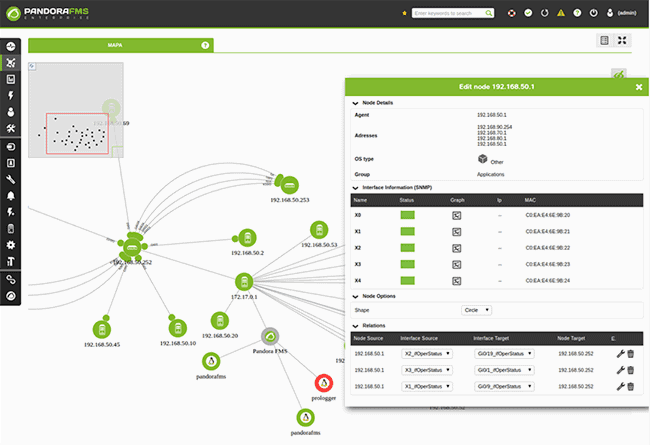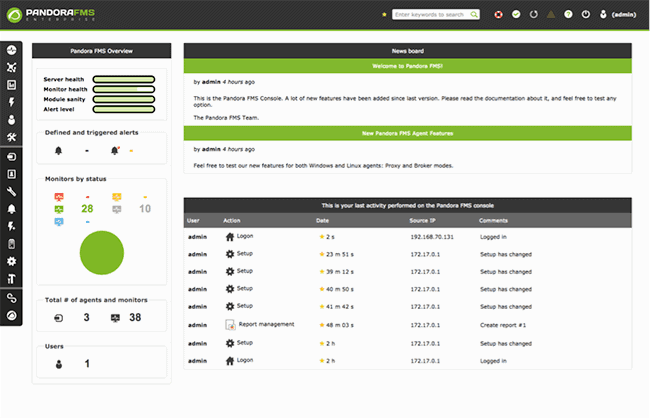Network administration in the IT sector is a Sisyphean task, an uphill battle to deal with new technologies, ward off cyber attacks, keep abreast of updates, and keep the tubes clean.
Maintaining a network at optimum performance, keeping in mind its cost, its evolution, and daily monitoring, can add up to a steep bill on headache pills. To save you a bit of cash on Advil, we’ve come up with five guidelines to help with network administration:
1. Select your material and human resources
2. Know your network
3. Know your devices
4. Be client-facing
5. Constant revision and evaluation
1. Choose the best resources, human and technological
To competently oversee a network requires training, and, if it’s backed up by official certification, so much the better. When you find the right person they need to be trained in the specific tool you use in your organization.
A tool like Pandora FMS is going to simplify your network administration, and give you a heads-up when something goes wrong. Pandora FMS’s visual components enable you to see all its operations at a glance, and on a single screen.
2. Know your network
As Francis Bacon declared “Scientia est potentia”, knowledge is power. Network mapping gives you that power, and the power that we are dealing with here is immeasurable: The power to understand the capacity, needs and resources of your network, and to administrate the hell out of it.
Depending on the size of your business, your network will be to scale, and, like precious, byte-based snowflakes, each one is different, but you still need to be aware of its operational protocols and its capacities. Without forgetting the Internet of Things, which gives you a window on a wider world outside your immediate office network, allowing you to track geographically vehicles, devices, cell phones, and so on, that are related to your business activities.

Network maps are your best friend for so many reasons that it’s surprising they don’t have their own Hallmark card:
- Detect/correct bad network behavior.
- Allow you to streamline your resources, and wring the last drop of MBs from your network.
- Reduce costs by controlling expenses.
- Let you know the geographic location of resources in a data center/server farm, for example; an invaluable help for the on-site technician.
- Better network security.
- Maintain quality control, with graphs, reports and reams of figures, accurate to four decimal places.
- Control updates and network patches, and avoid service interruptions.
3. Know your devices
Network administration is present in more fields than ever before, mixing it up with signals and images packaged together, voicemail with data services, different types of network – LAN, WAN, MAN, all employing different OSs and protocols.
A good sysadmin should know the devices present on the network, and adapt working practices to the environment: how each component operates in order to monitor them at maximum efficiency.
Technology is here to stay
Anyone who thought that the Internet was just a new kind of hula hoop or spacehopper – here today, gone tomorrow – probably feels pretty stupid right around now. Internet is here to stay, at least until The Big One hits, so get used to it. Furthermore, the Internet has migrated to a plethora of network-enabled devices, grouped together under the umbrella term, The Internet of Things, implying the need for new protocols, security, hardware, OSs, etc…
4. Client-facing. Always.
Real products for real people, real sysadmins overseeing real networks.
Pandora FMS is designed to be a multi-functional workhorse, with enough grunt to tame the wildest beasts on your IT setup. As a systems administrator, your task is to maintain the network and provide in-house and third-party support.
5. Review and evaluate processes
A network is like a woman complicated organism; constantly changing, never the same, frustrating, full of data that must be sifted to arrive at a true understanding, and requiring a lot of care and attention.
Achieving successful network management is a non-linear process with a lot of ups and downs. But, with the help of a good monitoring system like Pandora FMS you’ll see quick and efficient changes in your network monitoring.

We hope you enjoyed reading about our tips for network mastery. If you’re interested in subjugating your network to your will, visit the Pandora FMS website.
About Pandora FMS
Pandora FMS is a flexible monitoring system, capable of monitoring devices, infrastructures, applications, services and business processes.
Of course, one of the things that Pandora FMS can control is the hard disks of your computers.
Would you like to know more about what Pandora FMS can offer you? Discover it by entering here.
If you have more than 100 devices to monitor, you can contact us.
Do not hesitate to send us your queries. The Pandora FMS team will be happy to assist you!
Pandora FMS’s editorial team is made up of a group of writers and IT professionals with one thing in common: their passion for computer system monitoring. Pandora FMS’s editorial team is made up of a group of writers and IT professionals with one thing in common: their passion for computer system monitoring.


















